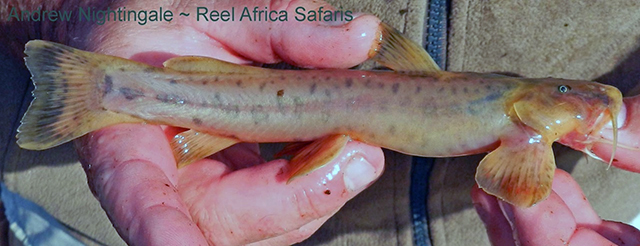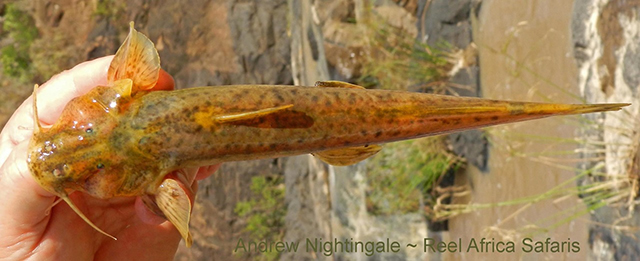Amphilius grandis Boulenger, 1905
Description
Dorsal spines (total): 0; Dorsal soft rays (total): 7 - 8; Anal spines: 0; Anal soft rays: 9; Vertebrae: 37 - 40. Diagnosis: Amphilius grandis is distinguished from A. chalei, A. cryptobullatus, A. krefftii, and A. uranoscopus by the absence of distinct pale patches at the origin and insertion of the dorsal fin; it differs from A. athiensis by the absence of small dark spots on head, body, and fins, vs. head, body, and fins finely spotted, and by having shorter inner mandibular barbels, 20.2-33.6% of head length vs. 33.3-42.0%; it also differs from A. cryptobullatus and A. krefftii by its forked caudal fin vs. emarginate, and from A. krefftii by its more elongate body with 37-40 total vertebrae, vs. usually 36 total vertebrae; it also differs from A. uranoscopus by its body colouration, uniformly brown or brown with large dark spots or blotches, vs. body grey with diffuse black stripe along side; it also differs from A. chalei by having a deeper body, body depth at anus 11.0-14.4% of standard length vs. 8.9-10.8%, and a shorter caudal peduncle, caudal peduncle length 14.6-19.0% of standard length vs. 19.0-21.9%, and it also differs from A. cryptobullatus by having normally developed bilateral bony swimbladder capsules, vs. bilateral bony swimbladder capsules extremely large (Ref. 85045).
Common Names
No common names available.
Taxonomic Hierarchy
Kingdom: Animalia
Phylum: Chordata
Class: Teleostei
Order: Siluriformes
Family: Amphiliidae
Genus: Amphilius
Species: Amphilius grandis Boulenger, 1905
Climate Zone
Location
Biology
Life cycle and mating behavior
Habitat
demersal

